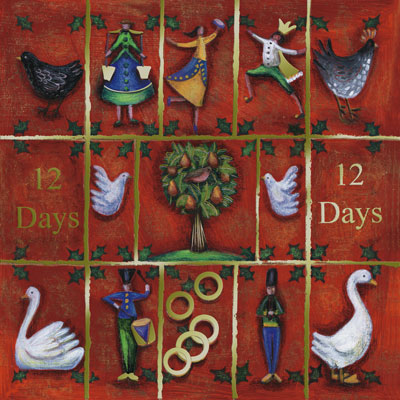 Let me begin with the obvious: A merry, merry 12th day of Christmas to one and all, if you are among the handful of Western Christians who mark this as the end of the traditional Christmas season (as opposed to the nonsectarian season between the first showing of "Elf" on cable TV and the first day of Christmas, which is Dec. 25).
Right now, if you search Google News for "12 days" and "Christmas," this is what you get. Click here.
Let me begin with the obvious: A merry, merry 12th day of Christmas to one and all, if you are among the handful of Western Christians who mark this as the end of the traditional Christmas season (as opposed to the nonsectarian season between the first showing of "Elf" on cable TV and the first day of Christmas, which is Dec. 25).
Right now, if you search Google News for "12 days" and "Christmas," this is what you get. Click here.
As you will note, there are a few stories mixed in there that focus on actual traditions in different cultures linked to the 12th day (or night) and the feast of the Epiphany. But as a rule, the mainstream press has moved on.
This is understandable. I mean, the Christmas ads have run their course.
However, a long, long time ago, 10 days or so before Christmas in fact, Religion News Service released an interesting news feature related to that famous folk song that everyone knows about this season, as in "The Twelve Days of Christmas." The key issue in the piece centers on this question: What is this song about and do the images in it have anything to do with Christianity? Here's a key piece of the story:
Given their unsuitability as gifts, how did dancing ladies, piping pipers, and a bevy of birds become part of one of the season's best-known carols? What, if anything, do they symbolize?
It depends on whom you ask.
The song has French origins, and was published in an English children's book called "Mirth without Mischief" around 1780. Most people believe it began as a memory game sung at Twelfth Night parties. The 12 days of Christmas in Western Christianity refer to the time between Christ's birth on Dec. 25 and the arrival of the Magi to honor the newborn, known as Epiphany, on Jan. 6.
In recent times, the song has been searched for coded references to Catholic doctrine, ancient Egyptian holidays, Roman myths, and the menu at medieval feasts. It has even become an annual index of economic inflation. Purchasing all the gifts from "Twelve Days" would cost about $23,400, an increase of more than 9 percent from last year, PNC Financial Services Group announced last month.
In the 1990s, a story began floating around the Internet that "The Twelve Days" was used as a secret catechism by Catholics persecuted after the Reformation in England. The "true love" who offers the gifts refers to God, according to this theory. The partridge is Jesus, the two turtle doves are the Old and New Testaments, the three French hens represent the virtues of faith, hope and charity, and so on.
This point of view about the mysterious song actually predates the Internet. However to see a perfect example of the digital-era phenomenon, click here for a sample. This particular version begins like this:
In 16th Century England, it was a crime to be a Catholic. Catholics were forbidden to practice their faith publicly and privately. Throughout history, when Catholics were persecuted they found little traditions to practice their faith and to recognize other Catholics. Thus came along "The Twelve Days of Christmas" to help young Catholics remember the tenets of their faith without getting caught.
Now, the minute people start pinning the "urban legend" label on this kind of message, that sends you straight to the oh-so-picky and invaluable people at Snopes.com, the vast web library that is ground zero for online myths and all kinds of modern folklore. The RNS report includes some solid information from those to accept the Snopes.com verdict that this "hidden catechism" view of the folk song is simple FALSE, with a big red warning label.
However, if you dig into the lengthy Snopes.com report, you will see that this subject gets a bit more complex. You'll also see that I have been interested in this mystery for a long time.
In my opinion, it's almost impossible to make a definitive judgment on the origins of any piece of folk music that is as old, and popular, as this one. Thus, I kept hunting until I found the Catholic priest who wrote the article that kicked off all of the chain letters, forwarded emails, etc., etc. It appears that this secret catechism story began with a Father Hal Stockert's research into the lives of embattled Jesuits in Elizabethan England.
One detail fascinated the priest, a reference to English Catholics using many symbolic songs and poems -- some serious, some light-hearted -- to help them cling to their faith. One children's song may have been part of a dance or a game and focused on the season between Dec. 25 and Jan. 6, the Feast of the Epiphany.
It began: "On the first day of Christmas, my true love gave to me, a partridge in a pear tree."
In the midst of his other research, Father Stockert took a few notes about "The Twelve Days of Christmas" and later wrote an article about the song for friends and parishioners. He posted this article -- complete with documentary references -- on an ecumenical computer site in 1982, back in the early days of online networks.
From there, the article went everywhere, with some Catholics and scores of Protestants writing and rewriting the text to suit their own purposes and biases. Alas, there is a sad twist in the priest's version of the final fate of his article:
Most importantly, none of these articles include his bibliographical references.
"I've got all kinds of people writing me demanding references for my work," he said. "I wish I could give them what they want, but all of my notes were ruined when our church had a plumbing leak and the basement flooded." Meanwhile, he said, his copy of the original article is on "a computer floppy disk that is so old that nobody has a machine that can read it, anymore."
As it turns out, the priest and the skeptics at Snopes.com are not all that far apart on many of their conclusions and Stockert was quick to say that -- back in 1999.
This [Snopes.com] site claims it is a secular song, probably with French roots. This "Twelve Days of Christmas" may also have become confused with a Christian song, which dates back to 1625, that is often called "In Those Twelve Days."
It is also possible, said Father Stockert, that a French song was claimed by English Catholics or that the two songs were blended.
"I'm sure there are elements of legend in this," he said. "But if it is a legend, it's a legend that dates back to the days of Queen Elizabeth. Maybe somebody will go dig this all up again."
There you go. Maybe RNS can follow up its fine story with even more research. The key to the mystery behind this strange little song is still out there somewhere.

